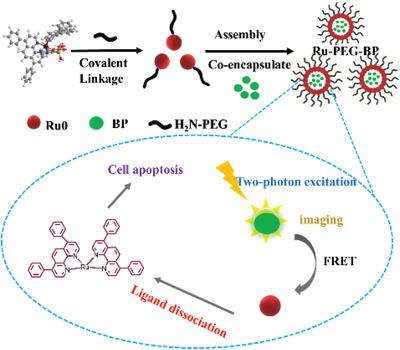当前位置:
X-MOL 学术
›
Part. Part. Syst. Charact.
›
论文详情
Our official English website, www.x-mol.net, welcomes your
feedback! (Note: you will need to create a separate account there.)
A Ru(II)‐Based Nanoassembly Exhibiting Theranostic PACT Activity in NIR Region
Particle & Particle Systems Characterization ( IF 2.7 ) Pub Date : 2020-04-15 , DOI: 10.1002/ppsc.202000045 Youchao Wang 1, 2 , Na Tian 1, 2 , Weize Sun 1, 2 , Boerhan Rena 1, 2 , Xusheng Guo 1, 2 , Yang Feng 1, 2 , Chao Li 1 , Xuesong Wang 1, 2 , Qianxiong Zhou 1
Particle & Particle Systems Characterization ( IF 2.7 ) Pub Date : 2020-04-15 , DOI: 10.1002/ppsc.202000045 Youchao Wang 1, 2 , Na Tian 1, 2 , Weize Sun 1, 2 , Boerhan Rena 1, 2 , Xusheng Guo 1, 2 , Yang Feng 1, 2 , Chao Li 1 , Xuesong Wang 1, 2 , Qianxiong Zhou 1
Affiliation

|
Photoactivated chemotherapy (PACT) has appealing merits over traditional chemotherapy as well as photodynamic therapy (PDT) by virtue of its spatial and temporal control on drug activity and oxygen‐independent mechanisms of action. However, the short photoactivation wavelengths, e.g., visible light–activated Ru(II)‐based PACT agents, limit the clinical application severely. In this work, a facile construction of supramolecular nanoparticles from a poly(ethylene glycol) (PEG)‐modified [Ru(dip)2(py‐SO3)]+ (abbreviated as Ru‐PEG, dip = 4,7‐diphenyl‐1,10‐phenanthroline, py‐SO3 = pyridine‐2‐sulfonate) and 1,3‐phenylenebis(pyren‐1‐ylmethanone) (BP) is shown. While Ru‐PEG may undergo photoinduced ligand dissociation and release anticancer species of [Ru(dip)2(H2O)2]2+, BP has extremely large two‐photon absorption cross sections (δ2) in the NIR region and intense fluorescence over the wavelengths where Ru‐PEG has strong absorption. Thus, two‐photon excitation of BP followed by an efficient Förster resonance energy transfer (FRET) from BP to Ru‐PEG may lead to a potent inactivation against cisplatin‐resistant cancer cells and 3D multicellular tumor spheroids (MCTSs). The residue fluorescence of BP also allows the cellular uptake of the particles to be visualized. This work provides a universal and convenient strategy to realize theranostic PACT in the ideal phototherapeutic window of 650–900 nm.
中文翻译:

基于Ru(II)的纳米组件在NIR区具有治疗性PACT活性
光活化化学疗法(PACT)凭借其对药物活性的时空控制和不依赖氧的作用机制,具有优于传统化学疗法和光动力疗法(PDT)的优点。但是,短的光激活波长,例如可见光激活的Ru(II)基PACT试剂,严重限制了临床应用。在这项工作中,由聚(乙二醇)(PEG)修饰的[Ru(dip)2(py-SO 3)] +(缩写为Ru-PEG,dip = 4,7-diphenyl )构成了超分子纳米粒子的简便结构-1,10-菲咯啉,py-SO 3=吡啶-2-磺酸盐)和1,3-苯撑双(吡喃-1-基甲酮)(BP)。而钌-PEG可以经历光致离解的配体和释放的的[Ru(DIP)的抗癌物质2(H 2 O)2 ] 2+,BP有非常大的双光子吸收截面(δ 2)在近红外区域,并且在Ru‐PEG具有强吸收能力的波长上具有强烈的荧光。因此,BP的双光子激发,然后从BP到Ru-PEG的有效Förster共振能量转移(FRET)可能导致针对顺铂耐药性癌细胞和3D多细胞肿瘤球体(MCTS)的有效灭活。BP的残留荧光还可以观察到颗粒对细胞的吸收。这项工作为在理想的650-900 nm的光疗窗口中实现治疗型PACT提供了一种通用且方便的策略。
更新日期:2020-04-15
中文翻译:

基于Ru(II)的纳米组件在NIR区具有治疗性PACT活性
光活化化学疗法(PACT)凭借其对药物活性的时空控制和不依赖氧的作用机制,具有优于传统化学疗法和光动力疗法(PDT)的优点。但是,短的光激活波长,例如可见光激活的Ru(II)基PACT试剂,严重限制了临床应用。在这项工作中,由聚(乙二醇)(PEG)修饰的[Ru(dip)2(py-SO 3)] +(缩写为Ru-PEG,dip = 4,7-diphenyl )构成了超分子纳米粒子的简便结构-1,10-菲咯啉,py-SO 3=吡啶-2-磺酸盐)和1,3-苯撑双(吡喃-1-基甲酮)(BP)。而钌-PEG可以经历光致离解的配体和释放的的[Ru(DIP)的抗癌物质2(H 2 O)2 ] 2+,BP有非常大的双光子吸收截面(δ 2)在近红外区域,并且在Ru‐PEG具有强吸收能力的波长上具有强烈的荧光。因此,BP的双光子激发,然后从BP到Ru-PEG的有效Förster共振能量转移(FRET)可能导致针对顺铂耐药性癌细胞和3D多细胞肿瘤球体(MCTS)的有效灭活。BP的残留荧光还可以观察到颗粒对细胞的吸收。这项工作为在理想的650-900 nm的光疗窗口中实现治疗型PACT提供了一种通用且方便的策略。











































 京公网安备 11010802027423号
京公网安备 11010802027423号